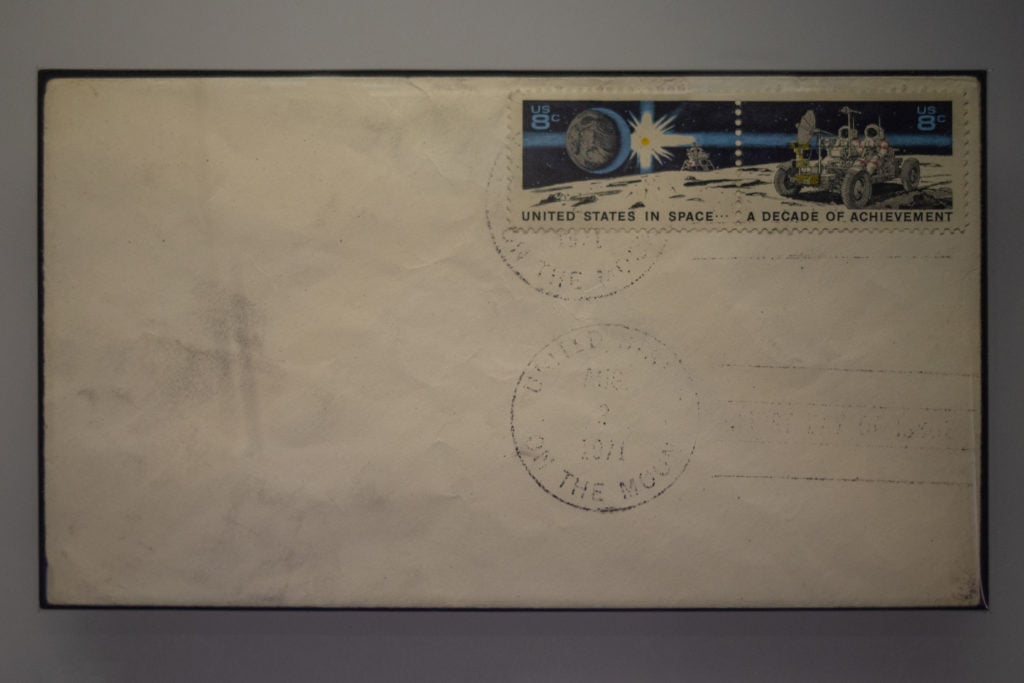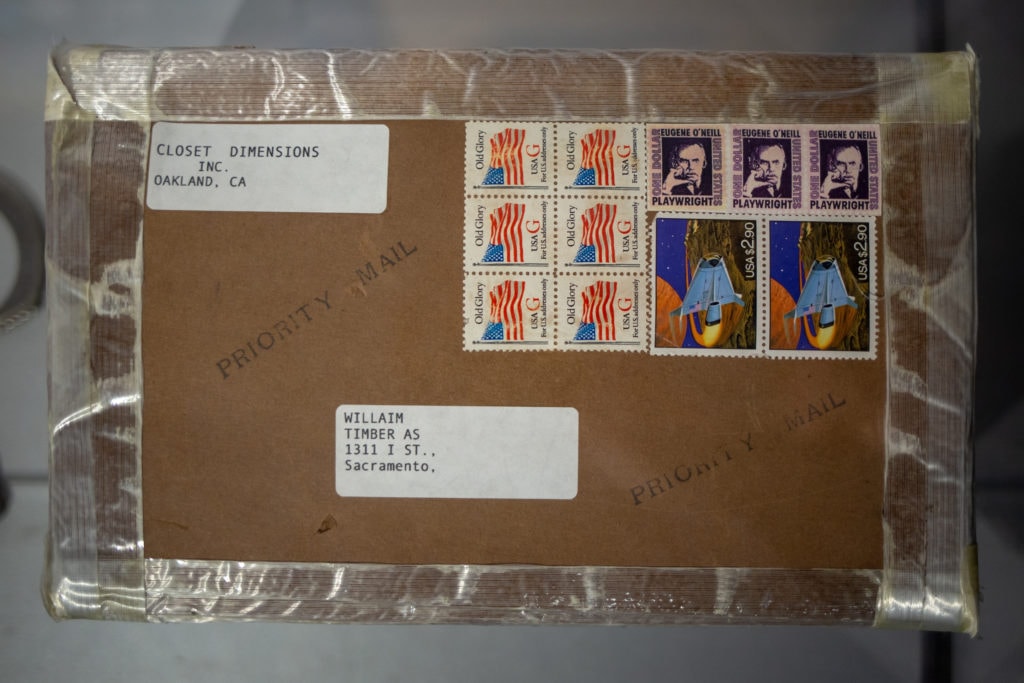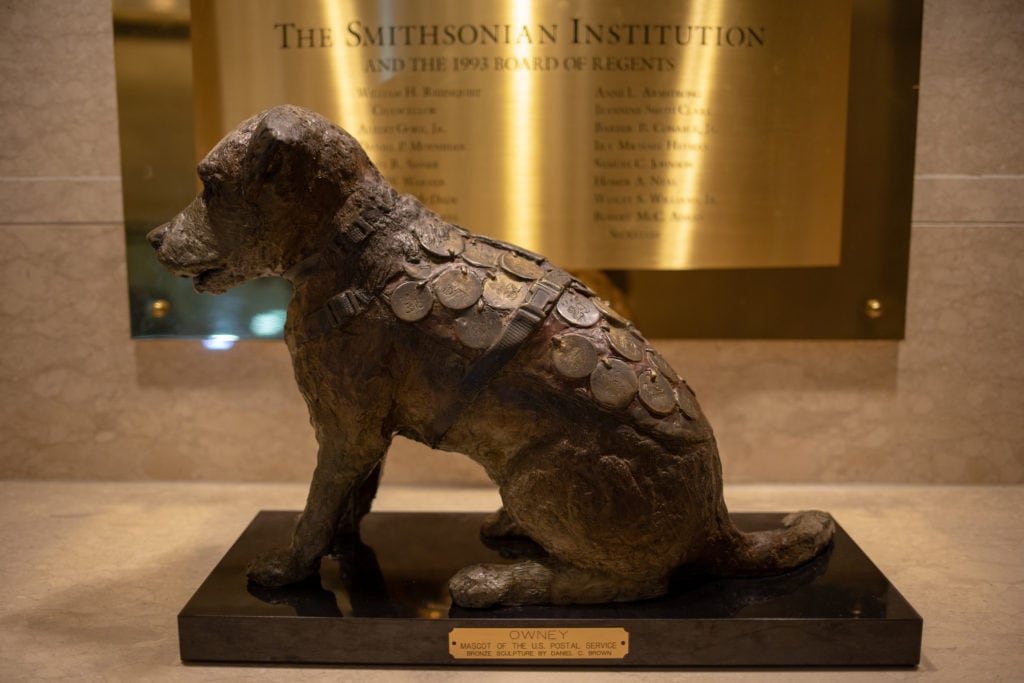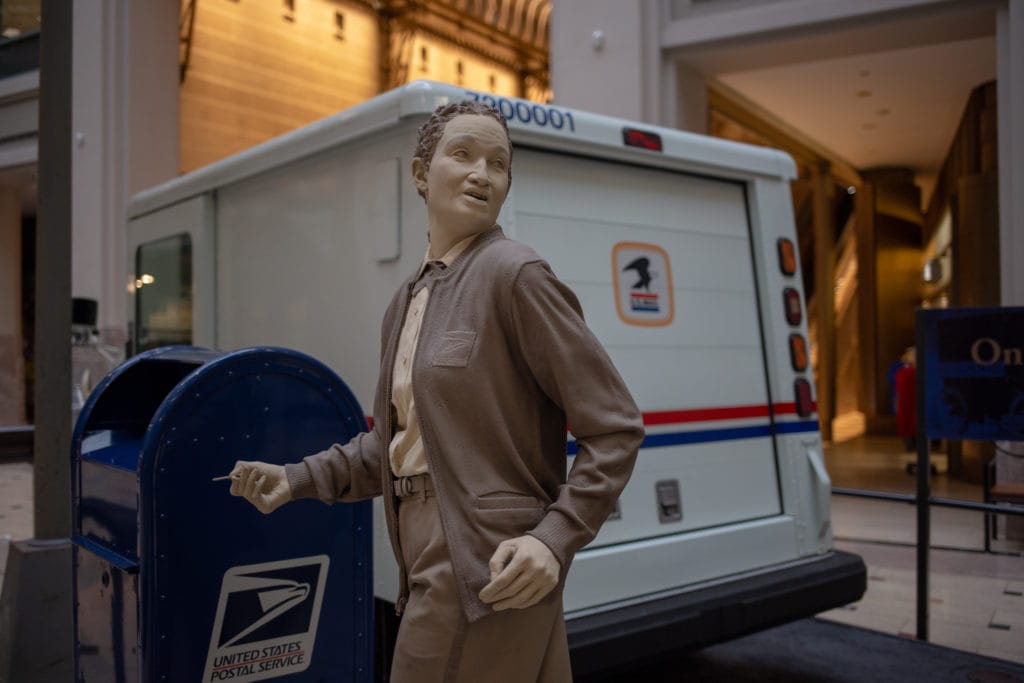Although the United States Postal Service has no official motto, the words engraved on the outside of the James A. Farley Post Office in New York are a good unofficial one: “Neither snow nor rain nor heat nor gloom of night stays these couriers from the swift completion of their appointed rounds.” After 1971, that phrase could have been appended to include “to any place in the universe.”
August 2, 1971 was the third and final day of the Apollo 15 mission to the Moon. U.S. astronaut Dave Scott reached under the seat of the Lunar Rover and pulled out an envelope bearing two 8-cent stamps. The stamps feature views of astronauts in space with the words “United States in space … a decade of achievement.”
Scott, playing double duty as both astronaut and postman, pulled out a cancellation device and marked the envelope—the ink was faint, so he tried again. The resulting postmarks indicate that the two stamps had been officially cancelled “on the moon” (the envelope also bears thumbprints from Scott’s spacesuit).




This “moon mail” is back on Earth now and on display at the National Postal Museum, located just northeast of the National Mall and across from Washington D.C.’s Union Station. While it may not be as well known as some of its flashier Smithsonian siblings, the National Postal Museum, dedicated to America’s postal history and philately (the collection and study of postage stamps), is no less charming. The museum, housed in a historic post office building, is full of interesting objects that illustrate the importance of a national mail system, including airplanes, train cars, handcuffs, uniforms, stamps, and one famous taxidermy dog.
Pilots and philatelists
Hanging from the atrium’s 90-foot-high ceiling are three vintage airmail planes. “The simple objective of getting folks their letters faster led to the birth of the commercial aviation industry,” says Ren Cooper, Public Affairs Specialist for the National Postal Museum.
The museum has several vehicles in its collection, including a railway mail car, an 1851 stagecoach, and postal trucks from 1931 and today. You’ll also find Amelia Earhart’s flight suit (she was a philatelist in addition to being a pilot), a pneumatic mail canister from 1893, and mailboxes from all over the world.



Pieces from notorious moments in mail history are on display as well, including a replica package representative of those sent by the Unabomber and handcuffs that were used to apprehend the suspect, Ted Kaczynski. A standard USPS mailbox from Princeton, New Jersey—used to mail infamous anthrax-laced letters in 2001—is streaked white from the decontamination process, and another mailbox came to the museum after surviving the 9/11 terrorist attacks in New York City.
No postal museum would be complete without the undisputed stars of any piece of mail: stamps. The museum’s William H. Gross Stamp Gallery is the world’s largest gallery dedicated to philately. The vast collection includes the world’s first adhesive stamp, an 1840 Penny Black, featuring Queen Victoria; the best-selling stamp of all time, the 1993 Elvis stamp; interactive displays; and more than 20,000 objects related to the history of these tiny works of art.


If you’re short on time, head straight for the Gems of American Philately exhibit to see some of the rarest and most valuable stamps in the museum’s collection. In addition to the moon mail, the exhibit includes a block of four Inverted Jennys—arguably the most famous mistake ever made by the postal service—Hawaiian missionary stamps, and America’s first stamps featuring Ben Franklin and George Washington.
“Through the lens of philately and the post, one can view our collective history in new and unique ways,” says Cooper.
An unofficial mascot
In 1775, the Second Continental Congress appointed Benjamin Franklin as Postmaster General, and by 1778 stagecoaches were delivering mail to 75 post offices around the country. Before 1863, postage only guaranteed that mail would be delivered from one post office to another. Customers had to travel—sometimes making very long and arduous journeys—to pick up their mail. That all changed in July, 1863, when Congress called for free home delivery in places “where income from local postage was more than sufficient to pay all expenses of the service.” By 1900, mail was hand-delivered in nearly 800 cities.
“It is incredible to consider how the rudimentary need to communicate has propelled national and international development—of systems and processes, infrastructure, new technologies, and more,” says Cooper.
After the Civil War, trains became the preferred method of mail transport. In 1888, a scruffy little dog became a regular at a post office in Albany, New York. How he got to the post office is a bit of a mystery—he was either a stray or he belonged to a postal clerk—but there is no question about Owney’s one true love: the mail.


Eventually, the mutt began to ride along with the mailbags as they traversed the country via Railway Mail Service train cars. RMS workers loved Owney and, because he was never involved in a train accident, considered him to be good luck. Owney also traveled internationally, following his beloved mailbags to Mexico, Alaska, Japan, China, and Egypt. Everywhere Owney went, people gave him special tags and he eventually accumulated so many that he was fitted with a special harness.
In 1894, the Brooklyn Daily Eagle reported that “When he jogs along, they jingle like the bells on a junk wagon.”





After Owney died in 1897, postal workers rallied to have their beloved mascot preserved and people can still pay their respects by visiting Owney in the National Postal Museum’s atrium. He’s still wearing his famous harness and the medals—one of which is shaped like a dog house—are engraved with the names of the cities, hotels, and post offices that Owney visited. Some are personalized with the phrases “Presented to his dogship,” and “Awarded to Owney the globetrotter.”
Constitutional mail
While moon cancellations are not the norm, the USPS is still an extraordinary institution. The Founding Fathers recognized the significance of a national Postal Service and it’s one of the only government agencies to be specifically authorized by the Constitution. The USPS processes and delivers 484.8 million pieces of mail every single day; they are the third-largest civilian employer in the U.S. and operate one of the largest civilian vehicle fleets in the world.
It’s easy to pick on the USPS—or grumble about a frustrating post office run—but America would probably look a whole lot different if it wasn’t for a National Postal Service. The fact that you can drop a letter into a box on one coast and a few days later it arrives on another is nothing short of miraculous. The USPS is obligated to provide the same services and prices to all Americans, regardless of location.






According to the USPS, “The Postal Service shall have as its basic function the obligation to provide postal services to bind the Nation together through the personal, educational, literary, and business correspondence of the people. It shall provide prompt, reliable, and efficient services to patrons in all areas and shall render postal services to all communities.”
It only makes sense then, that the USPS should have their own national museum. In 1886, the National Philatelic Collection was established with the donation of a sheet of 10-cent Confederate postage stamps. From those humble beginnings, the collection has grown significantly over the years and—thanks to gifts, donations, and occasional purchases—now includes nearly six million items.



This national collection of postal memorabilia was housed in the Smithsonian’s Arts and Industries Building from 1908 until 1963, and in 1964, it was moved to the National Museum of American History. In 1993, the National Postal Museum moved to its current home less than a mile north of the U.S. Capitol.
Fittingly, the museum—which includes a research library, a stamp store, and obligatory gift shop—is housed in the grand City Post Office Building, which operated as Washington D.C.’s main post office from 1914 until 1986. The breathtaking marble lobby has ornately carved ceilings, bronze chandeliers, and walls of gilded post office boxes. The entire building is a monument to a time when the government conveyed its gravitas by erecting imposing and highly decorative structures, an optimistic investment in the future of America and its institutions.
If you go
The National Postal Museum is open every day of the year except December 25, 10:00 a.m. to 5:30 p.m. and admission is always free.






